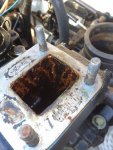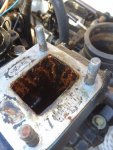Sangster21
Petty Officer 2nd Class
- Joined
- Mar 15, 2012
- Messages
- 130
I have posted bits of this previously, so here goes. Had my 250cu in I6 rebuilt in Nov by a reputable engine rebuilder. New pistons (.030 +) new cam, head redone (magnaflux, guides, valve grind, seals etc), full meal deal, didn't cheap out on anything. Fired up nicely, tuning on the muffs in the driveway, runs fine. Now comes an oops, rev the engine by hand and I had the idle cam in wrong and had throttle stuck open (engine racing) as long as it took me to run up and shut off ignition. Probably 5 seconds. A week later boat goes into the salt chuck for a sea trial, we run for a short time, discover we are starting to overheat (got up to 250 on gauge) and shut down. Turns out the throttle blip on the muffs totally toasted the leg water pump. Replaced pump. Finally got time last week to get the boat in the water again and run it. Runs fine happy happy, but I notice a whole lot of fluid that is condensing and dripping off the spark arrestor. Pull crankcase breather and it is puffing steam out a whole bunch.
I think this is not good so call it quits for the day and do some investigating. I pressure test the coolant system ( I have a San Juan cooling system) cold and it holds pressure. I run the engine on muffs again until it comes to temp and let it get hot. Again I note what I think is a lot of vapor coming from both dip stick and crank breather, again enough that it starts to drip out of the spark arrestor. I collect it in a can and I think it appears like coolant. I let the engine cool down enough to remove the rad cap and re pressure test the coolant system, we have a leak. In a few minutes it drops from 15psi down to 12 psi. I do not see any external signs of leak. I assume I have a head gasket issue.
I just pulled the head and don't see any obvious signs of a leak. I have done a quick check with precision straightedge and feeler guages and I find a max of about .002" out of flat on the cylinder head. Haven't had time to check the block yet. Also, the coolant which is essentially brand new looks pretty crappy, kinda cloudy and green/brownish... as if it was long overdue for a change.
Advice requested please.
I am going to give the head a really good cleaning and wire wheel the combustion chambers looking for cracks etc. Should I get it magnafluxed again? Should I pull the valves and inspect seats etc?
Do I need a marine specific head gasket for an engine that only sees antifreeze?
What else should I be doing before I put it all back together?
The engine rebuilder did have to do a thread repair due to crack in block on one of the front cylinder head bolt holes, he suggested this was not an uncommon issue with these engines, and it should be just fine.
Any words of wisdom from those that know would be much appreciated.
Regards,
Alan
I think this is not good so call it quits for the day and do some investigating. I pressure test the coolant system ( I have a San Juan cooling system) cold and it holds pressure. I run the engine on muffs again until it comes to temp and let it get hot. Again I note what I think is a lot of vapor coming from both dip stick and crank breather, again enough that it starts to drip out of the spark arrestor. I collect it in a can and I think it appears like coolant. I let the engine cool down enough to remove the rad cap and re pressure test the coolant system, we have a leak. In a few minutes it drops from 15psi down to 12 psi. I do not see any external signs of leak. I assume I have a head gasket issue.
I just pulled the head and don't see any obvious signs of a leak. I have done a quick check with precision straightedge and feeler guages and I find a max of about .002" out of flat on the cylinder head. Haven't had time to check the block yet. Also, the coolant which is essentially brand new looks pretty crappy, kinda cloudy and green/brownish... as if it was long overdue for a change.
Advice requested please.
I am going to give the head a really good cleaning and wire wheel the combustion chambers looking for cracks etc. Should I get it magnafluxed again? Should I pull the valves and inspect seats etc?
Do I need a marine specific head gasket for an engine that only sees antifreeze?
What else should I be doing before I put it all back together?
The engine rebuilder did have to do a thread repair due to crack in block on one of the front cylinder head bolt holes, he suggested this was not an uncommon issue with these engines, and it should be just fine.
Any words of wisdom from those that know would be much appreciated.
Regards,
Alan





















